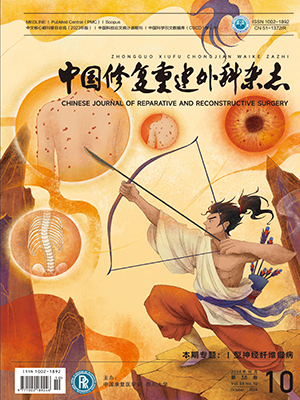| 1. |
Chuang TY, Ho WP, Chen CH, et al. Arthroscopic treatment of rotator cuff tears with shoulder stiffness: acomparison of functional outcomes with and without capsular release. Am J Sports Med, 2012, 40(9): 2121-2127.
|
| 2. |
Cho NS, Rhee YG. Functional outcome of arthroscopic repair with concomitant manipulation in rotator cuff tears with stiff shoulder. Am J Sports Med, 2008, 36(7): 1323-1329.
|
| 3. |
Oh JH, Kim SH, Lee HK, et al. Moderate preoperative shoulder stiffness does not alter the clinical outcome of rotator cuff repair with arthroscopic release and manipulation. Arthroscopy, 2008, 24(9): 983-991.
|
| 4. |
Tauro JC. Stiffness and rotator cuff tears: incidence, arthroscopic findings, and treatment results. Arthroscopy, 2006, 22(6): 581-586.
|
| 5. |
Gladstone JN, Bishop JY, Lo IK, et al. Fatty infiltration and atrophy of the rotator cuff do not improve after rotator cuff repair and correlate with poor functional outcome. Am J Sports Med, 2007, 35(5): 719-728.
|
| 6. |
Goutallier D, Postel JM, Gleyze P, et al. Influence of cuff muscle fatty degeneration on anatomic and functional outcomes after simple suture of full-thickness tears. J Shoulder Elbow Surg, 2003, 12(6): 550-554.
|
| 7. |
Yamaguchi K, Tetro AM, Blam O, et al. Natural history of asymptomatic rotator cuff tears: a longitudinal analysis of asymptomatic tears detected sonographically. J Shoulder Elbow Surg, 2001, 10(3): 199-203.
|
| 8. |
Gerber C, Fuchs B, Hodler J. The results of repair of massive tears of the rotator cuff. J Bone Joint Surg (Am), 2000, 82(4): 505-515.
|
| 9. |
Ho WP, Huang CH, Chiu CC, et al. One-stagearthroscopic repair of rotator cuff tears with shoulder stiffness. Arthroscopy, 2013, 29(8): 1283-1291.
|
| 10. |
Cho CH, Jang HK, Bae KC, et al. Clinical outcomes of rotator cuff repair with arthroscopic capsular release and manipulation for rotator cuff tear with stiffness: a matched-pair comparative study between patients with and without stiffness. Arthroscopy, 2015, 31(3): 482-487.
|
| 11. |
Park JY, Chung SW, Hassan Z, et al. Effect of capsular release in the treatment of shoulder stiffness concomitant with rotator cuffrepair: diabetes as a predisposing factor associated with treatment outcome. Am J Sports Med, 2014, 42(4): 840-850.
|
| 12. |
Kim YS, Lee HJ, Park I, et al. Are delayed operations effective for patients with rotator cuff tears and concomitant stiffness? An analysis of immediate versus delayed surgery on outcomes. Arthroscopy, 2015, 31(2): 197-204.
|
| 13. |
Sabzevari S, Kachooei AR, Giugale J, et al. One-stage surgical treatment for concomitant rotator cuff tears with shoulder stiffness has comparable results with isolated rotator cuff tears: a systematic review. J Shoulder Elbow Surg, 2017, 26(8): e252-e258.
|
| 14. |
Ellman H, Hanker G, Bayer M. Repair of the rotator cuff. End-result study of factors influencing reconstruction. J Bone Joint Surg (Am), 1986, 68(8): 1136-1144.
|
| 15. |
Michener LA, McClure PW, Sennett BJ. American Shoulder and Elbow Surgeons standardized shoulder assessment form, patient self-report section: reliability, validity, and responsiveness. J Shoulder Elbow Surg, 2002, 11(6): 587-594.
|
| 16. |
Tauro JC. Stiffness and rotator cuff tears: incidence, arthroscopic findings, and treatment results. Arthroscopy, 2006, 22(6): 581-586.
|
| 17. |
Seo SS, Choi JS, An KC, et al. The factors affecting stiffness occurring with rotator cuff tear. J Shoulder Elbow Surg, 2012, 21(3): 304-309.
|
| 18. |
Loew M, Heichel TO, Lehner B. Intraarticular lesions in primary frozen shoulder after manipulation under general anesthesia. J Shoulder Elbow Surg, 2005, 14(1): 16-21.
|
| 19. |
Baums MH, Spahn G, Nozaki M, et al. Functional outcome and general health status in patients after arthroscopic release in adhesive capsulitis. Knee Surg Sports TraumatolArthrosc, 2007, 15(6): 638-644.
|
| 20. |
Andersen NH, Søjbjerg JO, Johannsen HV, et al. Frozen shoulder: arthroscopy and manipulation under general anesthesia and early passive motion. J Shoulder Elbow Surg, 1998, 7(3): 218-222.
|




